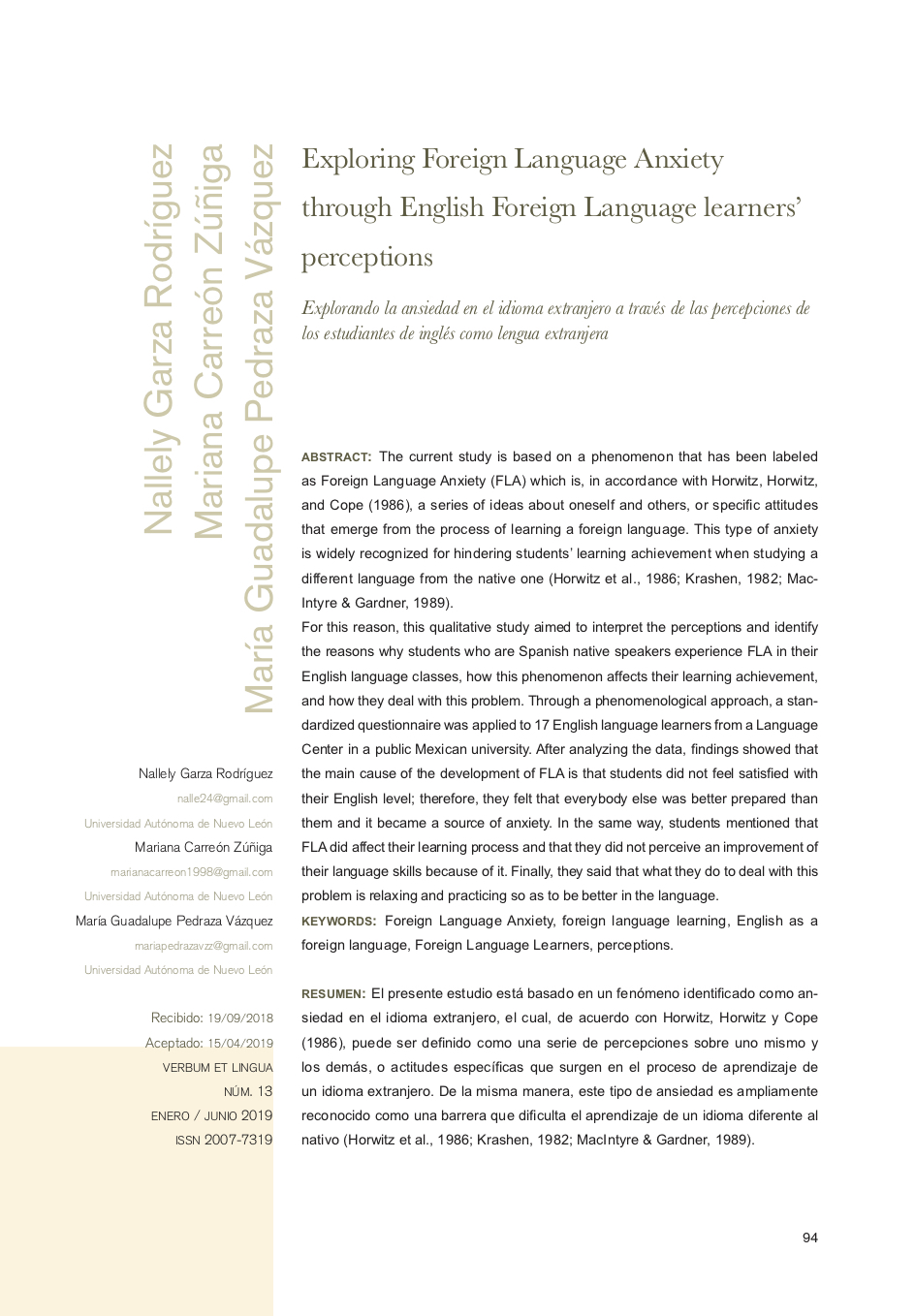Explorando la ansiedad en el idioma extranjero a través de las percepciones de los estudiantes de inglés como lengua extranjera
DOI:
https://doi.org/10.32870/vel.vi13.123Keywords:
Foreign Language Anxiety, foreign language learning, English as a foreign language, Foreign Language Learners, perceptionsAbstract
The current study is based on a phenomenon that has been labeled as Foreign Language Anxiety (FLA) which is, in accordance with Horwitz, Horwitz, and Cope (1986), a series of ideas about oneself and others, or specific attitudes that emerge from the process of learning a foreign language. This type of anxiety is widely recognized for hindering students’ learning achievement when studying a different language from the native one (Horwitz et al., 1986; Krashen, 1982; MacIntyre & Gardner, 1989).
For this reason, this qualitative study aimed to interpret the perceptions and identify the reasons why students who are Spanish native speakers experience FLA in their English language classes, how this phenomenon affects their learning achievement, and how they deal with this problem. Through a phenomenological approach, a standardized questionnaire was applied to 17 English language learners from a Language Center in a public Mexican university. After analyzing the data, findings showed that the main cause of the development of FLA is that students did not feel satisfied with their English level; therefore, they felt that everybody else was better prepared than them and it became a source of anxiety. In the same way, students mentioned that FLA did affect their learning process and that they did not perceive an improvement of their language skills because of it. Finally, they said that what they do to deal with this problem is relaxing and practicing so as to be better in the language.
Downloads
Metrics
References
Alkhateeb, H. M. (2014). Reading anxiety, classroom anxiety, language motivation, reader self-perception, and Arabic achievement of Arab-American students learning Arabic as a second language. Psychological Reports: Sociocultural Issues in Psychology, 115(3), 1–14.doi:10.2466/11. pr0.115c27z6
Aravena, E. S., Bascuñán, D. P., Briones, H. E., Jara, K. A., Lillo, D. A., Morales, G.J.,…Yumha, E. N. (2015). Second language acquisition theories: Their application in the ministry of education’s curriculum and their expected impact on teacher training programs from three Chilean universities (Undergraduate thesis, Universidad de Chile, Santiago, Chile). Retrieved from http://repositorio.uchile.cl/bitstream/handle/2250/130555/Second-language-acquisition-theories.pdf ?sequence=1
Baran-Łucarz, M. (2013). Phonetics Learning Anxiety – Results of a preliminary study. Research in Language, 11(1), 57-79. doi:10.2478/v10015-012-0005-9
Bensalem, E. (2018). Foreign Language Anxiety of EFL students: Examining the effect of self-efficacy, self-perceived proficiency and sociobiographical variables. Arab World English Journal, 9(2), 38-55. doi:10.24093/awej/vol9no2.3
Creswell, J. (2007). Qualitative inquiry and research design (2nd ed.). Lincoln: University of Nebraska.
Creswell, J. (2012). Educational research: planning, conducting, and evaluating quantitative and qualitative research (4th ed.). Lincoln: Pearson Education.
Dewaele, J.-M. (2007). The effect of multilingualism, sociobiographical, and situational factors on communicative anxiety and foreign language anxiety of mature language learners. International Journal of Bilingualism, 11(4), 391-409. doi:10.1177/13670069070110040301
Dewaele, J. M., & Al-Saraj, T. M. (2015). Foreign Language Classroom Anxiety of Arab learners of English: The effect of personality, linguistic and sociobiographical variables. Studies in Second Language Learning and Teaching, 5(2), 205–228. doi:10.14746/ssllt.2015.5.2.2
Dulay, H., & Burt, M. (1977). Remarks on Creativity in Language Acquisition. In M. Burt, H. Dulay, & M. Finocchiaro
(Eds.), Viewpoints on English as a Second Language (pp. 95-126). New York: Regents.
Eddles-Hirsch, K. (2015). Phenomenology and educational research. International Journal of Advanced Research, 3(8), 251–260. Retrieved from https://researchonline.nd.edu.au/edu_article/171/
Ewald, J. D. (2007). Foreign language learning anxiety in upper-level classes: involving students as researchers. Foreign Language Annals, 40(1), 122-142. doi:10.1111/j.1944-9720.2007.tb02857.x
Flick, U. (2009). An introduction to qualitative research (4th ed.) [ebook]. Retrieved from http://www.dphu.org/uploads/attachements/books/books_89_0.pdf
Garcia de Blakeley, M., Ford, R., & Casey, L. (2017). Second language anxiety among Latino American immigrants in Australia. International Journal of Bilingual Education and Bilingualism, 20(7), 759–772. doi: 10.1080/13670050.2015.1083533
Hashemi, M. (2011). Language stress and anxiety among the English language learners. Procedia-Social and Behavioral núm. 13 / enero-junio / 2019 111 Sciences, 30, 1811-1816. doi:10.1016/j.sbspro.2011.10.349
He, D. (2017). How to cope with Foreign Language Speaking Anxiety effectively? The case of university students in China. Electronic Journal of Foreign Language Teaching, 14(2), 159-174. Retrieved from http://e-flt.nus.edu.sg/
Horwitz, E. K., Horwitz, M. B., & Cope, J. (1986). Foreign language classroom anxiety. The Modern Language Journal, 70(2), 125–132.doi:10.1111/j.1540-4781.1986.tb05256.x
Huang, J. (2012). Overcoming foreign language classroom anxiety. United Kingdom: Nova Science Pub Inc.
Krashen, S. D. (1982). Principles and practice in second language acquisition. Oxford: Pergamon Press Inc.
Laverty, S. M. (2003). Hermeneutic phenomenology and phenomenology: A comparison of historical and methodological considerations. International Journal of Qualitative Methods, 2(3), 21–35. doi:10.1177/160940690300200303
Lien, H-Y. (2016). Effects of EFL individual learner variables on foreign language reading anxiety and metacognitive reading strategy use. Psychological Reports, 119(1), 124–135. doi:10.1177/0033294116659711
Lin, H-C.K., Chao, C-J. & Huang, T-C. (2015). From a perspective on foreign language learning anxiety to develop
an affective tutoring system. Education Tech Research Dev, 63(5), 727-747. doi:10.1007/s11423-015-9385-6
Liu, M. (2018). Bilingual/multilingual learners’ willingness to communicate in and anxiety on speaking Chinese and their associations with self-rated proficiency in Chinese. International Journal of Bilingual Education and Bilingualism, 21(1), 54-69. doi:10.1080/13670050.2015.1127889
Macayan, J. V., Quinto, E. J. M., Otsuka, J. C., & Cueto, A. B. S. (2018). Influence of language learning anxiety on L2 speaking and writing of Filipino engineering students. 3L: The Southeast Asian Journal of English Language Studies, 24(1), 40-55. doi:10.17576/3L-2018-2401-04
MacIntyre, P. D., & Gardner, R. C. (1989). Anxiety and second-language learning: Toward a theoretical clarification. Language Learning,39(2), 251-275. doi:10.1111/j.1467-1770.1989.tb00423.x
MacIntyre, P. D., & Gardner, R. C. (1991). Methods and results in the study of anxiety and language learning: a review of the literature. Language Learning, 41(1), 85-117. doi:10.1111/j.1467-1770.1991.tb00677.x
Mak, B. (2011). An exploration of speaking-in-class anxiety with Chinese ESL learners. System, 39(2), 202–214. doi:10.1016/j.system.2011.04.002
McLeod, S. A. (2018). Questionnaire. Simply Psychology. Retrieved from www.simplypsychology.org/questionnaires.html
Moeller, A. K., & Catalano, T. (2015). Foreign language teaching and learning. International Encyclopedia of the Social & Behavioral Sciences, 9(2), 327-332. doi:10.1016/B978-0-08-097086-8.92082-8
Roberts, T. (2013). Understanding the research methodology of interpretative phenomenological analysis. British
Journal of Midwifery, 21(3), 215–218. doi:10.12968/bjom.2013.21.3.215
Siniscalco, M., & Auriat, N. (2005). Questionnaire design. [ebook]. Retrieved from 112 N. Garza Rodríguez, M. Carreón Zúñiga y M. G. Pedraza Vázquez. Exploring Foreign Language Anxiety... http://unesdoc.unesco.org/images/0021/002145/214555E.pdf{
Woodrow, L. (2006). Anxiety and speaking English as a second language. RELC Journal, 37(3), 308-328. doi:10.1177/ 0033688206071315
Yim, S. Y. (2014). An anxiety model for EFL young learners: A path analysis. System, 42(1), 344–354. doi:10.1016/j. system.2013.12.022
Yin, R. (2011). Qualitative research from start to finish. London: Guilford Press.
Young, D. J. (1990). An Investigation of Students’ Perspectives on Anxiety and Speaking. Foreign Language Annals, 23(6), 539–553.doi:10.1111/j.1944-9720.1990.tb00424.x













